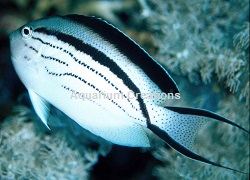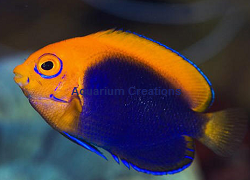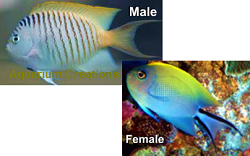
|
|
|
|
|
|
|
|
|
|
Angelfish-Dwarf
|
In the wild, the Saltwater Dwarf Angelfish diet consists mainly of algae and tunicates. Angels require plenty of live rock for picking off of and they should be given a balanced diet. Therefore introduce your Saltwater Angel fish into a well-established aquarium with an ample supply of algae and other live rock growth will present the best opportunity for their long life. The majority of Dwarf Angel fish adapt well to life in a display tank. Variety is important. Feed marine angels foods from a wide range of food groups. Feeding a single type of food for too long is generally a bad idea. By providing this type of habitat it stimulates Angels feeding instincts, which in turn helps them adjust to accepting tank fed aquarium foods such as Spirulina, nori and other dried or frozen preparations for herbivores, vitamin-enriched and color enhanced marine flakes, live brine or mysid shrimps, finely chopped dried or frozen crustacean or other high-quality meaty fares suitable for carnivores. Dwarf Angelfish also need to be fed algae and nori sheets as well as a good pellet food. Foods that are not already vitamin-enriched can be soaked in a liquid vitamin supplement such as Selcon. This helps prevent Dwarf Angel fish disorders such as head and lateral line erosion (HLLE). |
|
|
Lamarck's Angelfish Genicanthus lamarck  TankRecommendations: Provide a 100 gallon or larger tank with large amounts of live rock for hiding and grazing on micro fauna. Food and diet: It is important to give it a varied diet in the aquarium but you don’t have to feed it zooplankton; various types of meaty food is known to work well. You can for instance make your own formula by mixing seafoods like shrimps, squid, mussels, clams etcetera with each other and adding some vegetables, e.g. spinach or green peas. Adding algae to the diet is recommended, e.g. fresh and marine algae + spirulina. Lamarck's angelfish will also like angelfish preparations and live food such as brine shrimp and mysid shrimp. Level of Care: Moderate Acclimaton Time: 3+ hours Reef Compatibility : Reef Safe Approximate Purchase Size: Small: 1" to 2"; Medium: 2" to 3"; Large: 3" to 4-1/2" Female Medium $49.99 Male Medium $99.99 Female Large $59.99 Male Large $149.99 |
African Flameback Angelfish Centropyge acanthops  TankRecommendations: Provide a 50 gallon or larger tank with large amounts of live rock for hiding and grazing on micro fauna. Food and diet: African Flameback Angelfish require a varied diet that contains both plant and animal matter. They do best with smaller food items like brine shrimp, mysis shrimp, dwarf angelfish frozen foods, staple flake foods (Formula I & II) and other similar foods designed for marine omnivores. They will also appreciate the grazing opportunities that mature live rock provides in terms of algae, sponge and small organisms that are found growing on the surface of established live rock. Level of Care: Moderate Acclimaton Time: 3+ hours Reef Compatibility :Not Reef Safe Approximate Purchase Size: Small: 1/2" to 1"; Medium: 1" to 2"; Large: 2" to 3" Medium $64.99 Large Out of Stock |
Swallowtail Angelfish Genicanthus melanospilos  Identification: Also called Blackspot or Spotbreast Angelfish. The female is yellow dorsally and light blue ventrally. The caudal fin is marine-blue highlighted by a dark, blue-black edging on the top and bottom. The male is marked with a series of vertical red stripes covering the entire pale colored body. The tail of the male is forked and is yellow with blue edges. One of the more brightly colored of its Genus, the Swallowtail Angelfish is an excellent species to have in the home aquarium. Like its cousins, the Swallowtail Angelfish feeds on Zooplankton, not Sponges, Corals or any other sessile Invertebrate. This makes it an excellent candidate for a Reef type aquarium or a community aquarium with other Angelfish. TankRecommendations: Provide a 125 gallon or larger tank with large amounts of live rock for hiding and grazing on micro fauna. Food and diet: It is important to give it a varied diet in the aquarium but you don’t have to feed it zooplankton; various types of meaty food is known to work well. You can for instance make your own formula by mixing seafoods like shrimps, squid, mussels, clams etcetera with each other and adding some vegetables, e.g. spinach or green peas. Adding algae to the diet is recommended, e.g. fresh and marine algae + spirulina. Swallowtail angelfish will also like angelfish preparations and live food such as brine shrimp and mysid shrimp. Level of Care: Moderate Acclimaton Time: 3+ hours Reef Compatibility : Reef Safe Approximate Purchase Size: Small: 1-1/2" to 2"; Medium: 2" to 3"; Large: 3" to 4.5" Female Medium $69.99 Male Medium $149.99 Female Large $99.99 Male Large $169.99 |
|
|
|
|
|
Copyright 2018 Aquarium Creations Online Photos are representative of each species. All marine life will be unique and variations should be expected, color and sizes may vary. *Guarantee Restriction: All of our livestock are guaranteed. However for one or more of these species, they may be marked with a guarantee restriction. If it does, it means the specific animal may not handle stress from environmental conditions well. These stresses can include poor water quality, harassment from tank mates or confined aquarium conditions. When stressed, these species can lose the ability to ward off infection and disease. Other species may be listed as Restricted because they have such specialized feeding requirements that is difficult recreate in a aquarium and may succumb to malnutrition. |